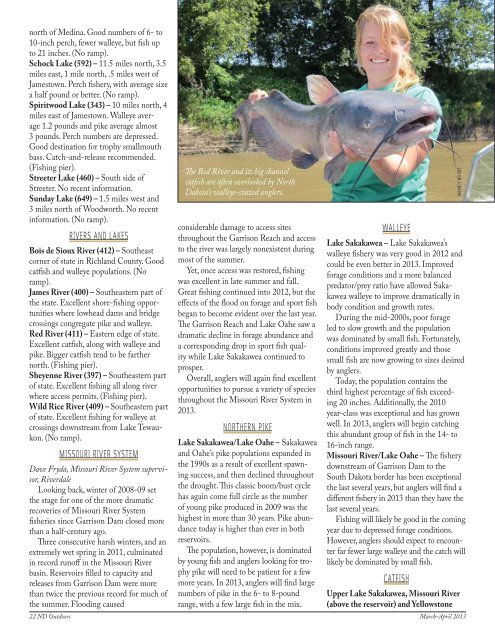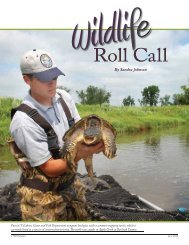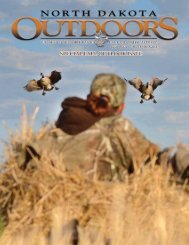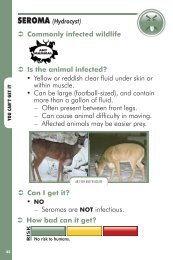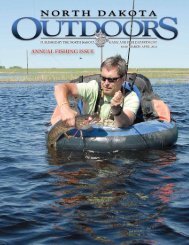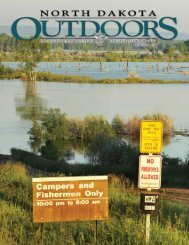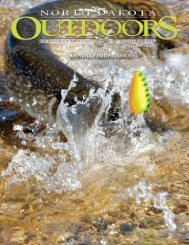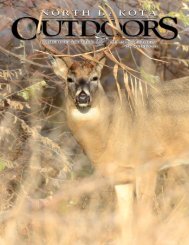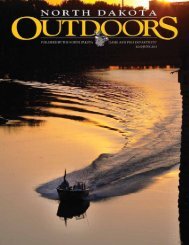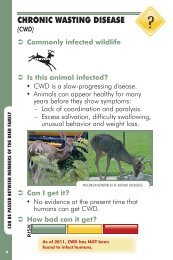north of Medina. Good numbers of 6- to10-inch perch, fewer walleye, but fish upto 21 inches. (No ramp).Schock Lake (592) – 11.5 miles north, 3.5miles east, 1 mile north, .5 miles west ofJamestown. Perch fishery, with average sizea half pound or better. (No ramp).Spiritwood Lake (343) – 10 miles north, 4miles east of Jamestown. Walleye average1.2 pounds <strong>and</strong> pike average almost3 pounds. Perch numbers are depressed.Good destination for trophy smallmouthbass. Catch-<strong>and</strong>-release recommended.(<strong>Fish</strong>ing pier).Streeter Lake (460) – South side ofStreeter. No recent information.Sunday Lake (649) – 1.5 miles west <strong>and</strong>3 miles north of Woodworth. No recentinformation. (No ramp).RIVERS AND LAKESBois de Sioux River (412) – Southeastcorner of state in Richl<strong>and</strong> County. Goodcatfish <strong>and</strong> walleye populations. (Noramp).James River (400) – Southeastern part ofthe state. Excellent shore-fishing opportunitieswhere lowhead dams <strong>and</strong> bridgecrossings congregate pike <strong>and</strong> walleye.Red River (411) – Eastern edge of state.Excellent catfish, along with walleye <strong>and</strong>pike. Bigger catfish tend to be farthernorth. (<strong>Fish</strong>ing pier).Sheyenne River (397) – Southeastern partof state. Excellent fishing all along riverwhere access permits. (<strong>Fish</strong>ing pier).Wild Rice River (409) – Southeastern partof state. Excellent fishing for walleye atcrossings downstream from Lake Tewaukon.(No ramp).MISSOURI RIVER SYSTEMDave Fryda, Missouri River System supervisor,RiverdaleLooking back, winter of 2008-09 setthe stage for one of the more dramaticrecoveries of Missouri River Systemfisheries since Garrison Dam closed morethan a half-century ago.Three consecutive harsh winters, <strong>and</strong> anextremely wet spring in 2011, culminatedin record runoff in the Missouri Riverbasin. Reservoirs filled to capacity <strong>and</strong>releases from Garrison Dam were morethan twice the previous record for much ofthe summer. Flooding causedThe Red River <strong>and</strong> its big channelcatfish are often overlooked by <strong>North</strong><strong>Dakota</strong>’s walleye-crazed anglers.considerable damage to access sitesthroughout the Garrison Reach <strong>and</strong> accessto the river was largely nonexistent duringmost of the summer.Yet, once access was restored, fishingwas excellent in late summer <strong>and</strong> fall.Great fishing continued into 2012, but theeffects of the flood on forage <strong>and</strong> sport fishbegan to become evident over the last year.The Garrison Reach <strong>and</strong> Lake Oahe saw adramatic decline in forage abundance <strong>and</strong>a corresponding drop in sport fish qualitywhile Lake Sakakawea continued toprosper.Overall, anglers will again find excellentopportunities to pursue a variety of speciesthroughout the Missouri River System in2013.NORTHERN PIKELake Sakakawea/Lake Oahe – Sakakawea<strong>and</strong> Oahe’s pike populations exp<strong>and</strong>ed inthe 1990s as a result of excellent spawningsuccess, <strong>and</strong> then declined throughoutthe drought. This classic boom/bust cyclehas again come full circle as the numberof young pike produced in 2009 was thehighest in more than 30 years. Pike abundancetoday is higher than ever in bothreservoirs.The population, however, is dominatedby young fish <strong>and</strong> anglers looking for trophypike will need to be patient for a fewmore years. In 2013, anglers will find largenumbers of pike in the 6- to 8-poundrange, with a few large fish in the mix.WALLEYELake Sakakawea – Lake Sakakawea’swalleye fishery was very good in 2012 <strong>and</strong>could be even better in 2013. Improvedforage conditions <strong>and</strong> a more balancedpredator/prey ratio have allowed Sakakaweawalleye to improve dramatically inbody condition <strong>and</strong> growth rates.During the mid-2000s, poor forageled to slow growth <strong>and</strong> the populationwas dominated by small fish. Fortunately,conditions improved greatly <strong>and</strong> thosesmall fish are now growing to sizes desiredby anglers.Today, the population contains thethird highest percentage of fish exceeding20 inches. Additionally, the 2010year-class was exceptional <strong>and</strong> has grownwell. In 2013, anglers will begin catchingthis abundant group of fish in the 14- to16-inch range.Missouri River/Lake Oahe – The fisherydownstream of Garrison Dam to theSouth <strong>Dakota</strong> border has been exceptionalthe last several years, but anglers will find adifferent fishery in 2013 than they have thelast several years.<strong>Fish</strong>ing will likely be good in the comingyear due to depressed forage conditions.However, anglers should expect to encounterfar fewer large walleye <strong>and</strong> the catch willlikely be dominated by small fish.CATFISHUpper Lake Sakakawea, Missouri River(above the reservoir) <strong>and</strong> Yellowstone22 ND Outdoors <strong>March</strong>-<strong>April</strong> 2013NANCY BOLDT
River – A strong catfish population, withsome fish exceeding 10 pounds. This iswhere anglers will find the best chanceto catch a big cat in the Missouri RiverSystem. Anglers who target the area fromWilliston to the Missouri River <strong>and</strong> YellowstoneRiver confluence are generallyquite successful during the open water season,<strong>and</strong> fair numbers of catfish are caughtthrough the ice.Lake Sakakawea – Good population ofcats throughout the reservoir, but the bestnumbers <strong>and</strong> fishing success are in theupper end. Catfish abundance in LakeSakakawea generally increased during thelast drought <strong>and</strong> likewise began to increaseagain in 2012 due to declining lake elevations.Garrison Dam Tailrace – Provides somegood fishing for smaller catfish, especiallyin summer. Cats from this area are greattable fare thanks to relatively cold waterthroughout summer.Missouri River, south of GarrisonDam – Catfish are abundant in this reach,<strong>and</strong> good fishing often occurs around themouths of tributaries <strong>and</strong> well upstreamduring good flow conditions.SALMONMissouri River System – The MissouriRiver salmon fishery was greatly affectedby high water in 2011, but recovereddramatically in 2012. Salmon fishing onLake Sakakawea was exceptional last year,with an abundance of quality-sized fishharvested by anglers.While habitat conditions <strong>and</strong> forageabundance remain good, the quality of theLake Sakakawea salmon fishery in 2013is unknown. Salmon stocked during the2011 flood will be the dominant portionof salmon available to anglers in 2013.However, it is unknown to what extentthose young salmon were flushed throughGarrison Dam. High entrainment of adultsalmon was experienced in 2011, but fishingstill proved good in 2012. Hopefully,that trend continues this year.WHITE BASSMissouri River System – Lake Oahetypically has a much better white bassfishery than Lake Sakakawea. White bass,however, experienced a severe die-off inOahe a few years ago <strong>and</strong> have not fullyrecovered. Natural reproduction wasexceptional in 2009, but a large die-offof young bass was also reported. Overall,white bass abundance remains well belowpast levels.SMALLMOUTH BASSLake Sakakawea – Similar to northernpike, smallmouth bass abundance declineddue to low water <strong>and</strong> poor spawning habitat.However, reproduction was exceptionalbeginning in 2008, <strong>and</strong> anglers have beenencountering good numbers of fish in thelast couple of years.In 2012, anglers caught a high numberof Whopper-sized smallmouth bass fromLake Sakakawea. Abundance <strong>and</strong> size ofsmallmouth should remain exceptional in2013.TROUTGarrison Dam Tailrace continues toproduce trophy brown, rainbow <strong>and</strong> cutthroattrout. Rainbow trout have doneespecially well, with good numbers of 5- to10-pound fish caught by anglers.The Tailrace brown trout fishery hasslowed in recent years, but still containsworld-class-sized fish. A 20-pound brownis always a possibility.Cutthroat trout have not done quite sowell in recent years. Following their initialboom in the early 2000s, the populationhas declined in numbers <strong>and</strong> qualitydespite continued stocking.DEVILS LAKE BASINR<strong>and</strong>y Hiltner, district fisheries supervisor,<strong>and</strong> Todd Caspers, fisheries biologist, bothDevils LakeWALLEYEDevils Lake – Continues to support alarge walleye population. Most of the fishare less than 16 inches. The past severalyears of excellent reproduction have producedmany fish that are now 8-16 inches.Larger fish are available, but at lowerdensities than several years ago, partiallybecause of low walleye reproduction from2003-05.Devils Lake’s walleye population continuesto thrive, with significant naturalreproduction <strong>and</strong> periodic small stockings.<strong>Fish</strong>ing opportunities will extend into thefuture as good densities of young fish arebeing recruited into the fishery.Stump Lake – A good population of walleye,most are less than 18 inches.Lake Irvine – Good numbers of walleye,with most under 20 inches.NORTHERN PIKEDevils Lake – As water levels rise, theupper regions of the lake have exp<strong>and</strong>ed<strong>and</strong> provided excellent spawning habitat.As a result, pike natural reproduction hasbeen high the past several years.There will be great pike fishing opportunitiesin 2013. Pike can save a slow dayof fishing as they are willing biters, especiallyin spring. <strong>Fish</strong> can be found lakewide<strong>and</strong> most are between 20-30 inches,but there are some larger pike as well.Stump Lake – Pike are common. Goodnumbers of medium- to larger-sized fishas well.Lake Irvine – High numbers of mediumsizedpike. While most fish are under 5pounds, there are some larger pike as well.YELLOW PERCHDevils Lake – Perch densities have slowlyincreased as a result of two strong hatchesin 2006-07 <strong>and</strong> 2011. Population sizestructure is somewhat top heavy withbigger fish because of limited hatchingsuccess in recent years.However, the 2011 hatch looked strong<strong>and</strong> these fish did show up in the 2012survey as 5-6 inchers, so future recruits arepresent. Perch fishing should be good thiscoming winter, but not as good as the lastboom of the late 1990s <strong>and</strong> early 2000s.Stump Lake – Perch population is increasing,with good numbers of medium-sizedfish, with some big fish, too.Lake Irvine – Yellow perch numbers arelow, but the few perch in the lake aregood-sized.WHITE BASSDevils Lake – White bass densities havedecreased from a recent high in 2008.However, bass are still common <strong>and</strong> manyare 14 inches or longer.Stump Lake – White bass are currently atlow densities.Lake Irvine – Numbers are low, but likeperch, the few white bass in the lake aregood-sized.<strong>March</strong>-<strong>April</strong> 2013 ND Outdoors 23


